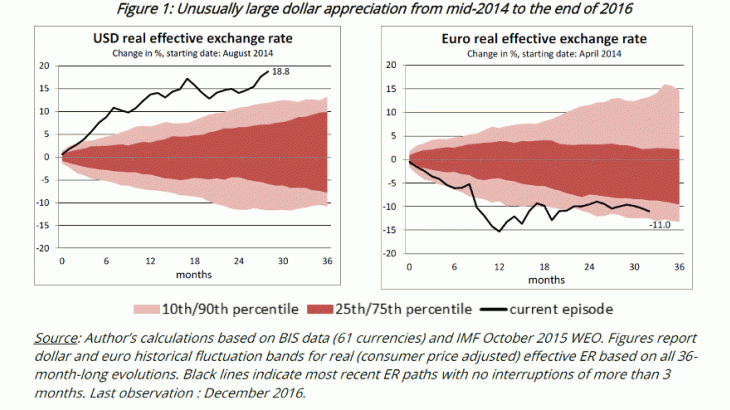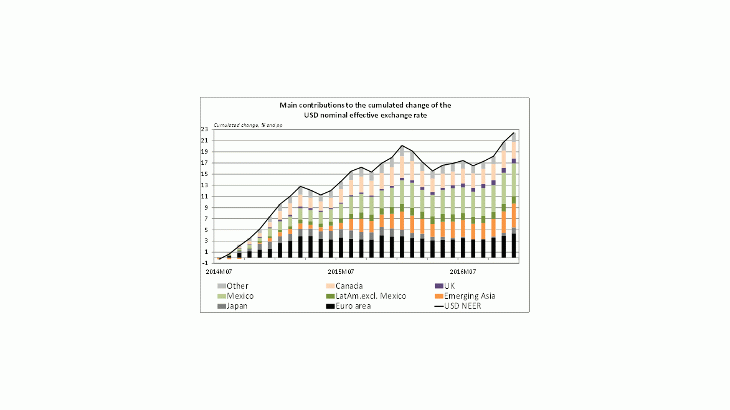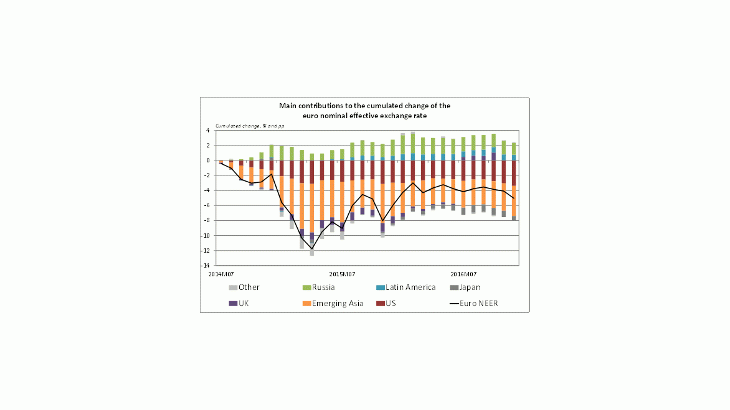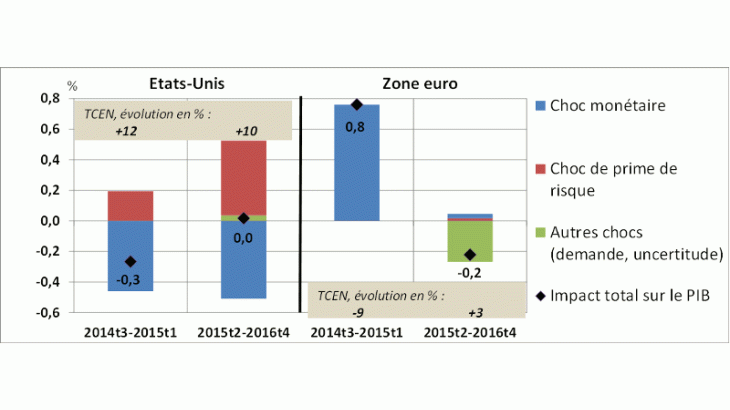Figure 2 points to two distinct phases in dollar and euro fluctuations:
- From 2014Q3 to 2015Q1: the euro, Yen and Canadian dollar were significant contributors to the dollar’s rise, pointing to an appreciation due to business and monetary cycle gaps (left panel). The rising share of emerging countries in the dollar appreciation, notably the Mexican peso, also points to a flight to the dollar in face of falling commodity prices and lower growth forecasts for Emerging Market Economies (EMEs). As a mirror image to the dollar, the euro depreciation appears to have been generated by a divergence in monetary policy expectations (right panel).
- From 2015Q2 to 2016Q4: this period was characterized by a continued weakness in commodity prices and cuts in commodity exporters’ outlook. As a result, the flight to the dollar, as well as other commodity-importers’ currencies such as the euro, intensified. Divergence in interest rate paths between the US and its main trading partners contributed also to the dollar’s appreciation towards the end of the period.
‘Good’ versus ‘bad’ currency appreciations
The impact of ER movements on inflation and activity has been the focus of numerous studies, looking more particularly at the relationship between ER movements and export and import prices (the ER Pass-Through) – see for example https://publications.banque-france.fr/en/economic-and-financial-publications-working-papers/global-trade-flows-revisiting-exchange-rate-elasticities. However, most studies tend to overlook the source of ER changes, with few exceptions so far as in Forbes.
Using the National Institute Global Econometric Model (NiGEM), a quarterly global structural model of the world economy devised by the National Institute of Economic and Social Research, Kirby and Meaning point at different ER Pass-Throughs due to structural features of the economy but also due to the causes of ER fluctuations.
We follow Kirby & Meaning by running two types of shocks in NiGEM: a fall in the risk premium and a rise in the official interest rate, both generating a 5% appreciation in the nominal effective exchange rate of the dollar and the euro. Model results point to risk premium shocks being neutral (EA) or even positive (US) for growth, due to monetary policy space available for the latter but not the former at the time of the shock.
Yet monetary policy shocks are clearly more painful to activity as they imply a rise in the official interest rate. In our scenario, the Fed Funds and 3-month Euribor rates increase instantaneously by 70bp to generate an appreciation of around 5% in the dollar and euro nominal effective ERs. The transmission to GDP is rapid and significant for both the US and EA, as higher interest rates reduce investment.
Based on these results, we build a scenario where the dollar and the euro experience three types of shocks (a monetary policy shock, a risk premium shock, a negative demand shock in China, Brazil, Russia, Turkey and South Africa, where domestic demand falls 2% compared to the baseline), calibrated so as to reproduce the $ and € fluctuations observed since mid-2014.
EA more sensitive to currency appreciation than the US
According to NiGEM simulations, the 20% appreciation of the dollar since mid-2014 choked 0.2pp off growth in the US (see figure 3). But as the source of the dollar’s appreciation evolved over time, its transmission to the US economy has been quite distinct as well:
- an initial negative impact on GDP as growth and interest rates differentials led to diverging monetary expectations, not fully compensated by a fall in the currency risk premium;
- followed by an initially positive impact on GDP as rising risk premia in emerging and commodity exporters triggered a flight to the dollar.
- However, the effect has been recently wiped out by increasing interest rate gaps between the US and its main trading partners, following D. Trump’s election and prospects of stronger growth and more interest rate hikes. As shown above, a dollar appreciation driven by monetary decoupling could be more harmful to US growth than a fall in the currency risk premium.
The case for the euro is different as the currency initially depreciated, boosting GDP growth, but has been appreciating since 2015Q2. Interestingly, as both the dollar and the euro were faced with the same type of shock in the first part of 2015 (namely, a negative shock to foreign demand), the estimated impact has been proportionally more negative for the EA than for the US. Higher openness of the EA, as well as a larger exposure to EMEs, could be an explanation. As a result, a loss in price-competitiveness could prove more challenging to activity in the EA than in the US.
Results should be interpreted with caution, however, as they rely heavily on the model’s estimated elasticities and parameters, invariant to economic policies. Moreover, the initial condition matters for the simulation results. Indeed, ER depreciations tend to have more impact when economic slack is high. Last, the identification of the underlying sources of the dollar and euro fluctuations is based on the observation of the contribution of third countries’ currencies and not on ER models per se.



